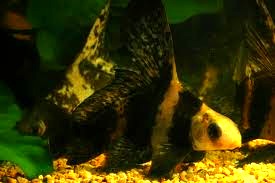
So you’ve always wanted to tell people that you have a shark pond. The goldfish pond was too tame and the koi pond doesn’t feel edgy enough for you right? Now here is a way around that dilemma, without you having to build a 150,000 gallon saltwater heated backyard pond. The Chinese Hi Fin Banded Shark! This shark can easily make a home in your pond. This shark you will not have to feed seal lions and penguins for its daily meals. This shark you do not need to run from the waters edge to get away from. You might even want to step closer and get a good look because of the impressive bold markings on this fish. It’s strong symmetrical pattern with vertical bands of contrasting black and off-white colors make this fish a whole different type of eye catcher than your koi or goldfish are.
Yes it is from China, yes it is high finned, but no, it is not a shark. They certainly cannot play cards (I’ve tried) and they bear no close relation to any of the sea and ocean dwelling sharks that we think of when we hear “shark!” Myxocyprinus asiaticus, or the Chinese Hi Fin Banded shark is probably better known in the aquarium trade but it indeed makes a great addition to your pond population. Some of its best traits are that it is compatible with goldfish, koi, and a many other pond fish, it is cold tolerant for those pond owners in colder regions, and AND! they eat algae! An algae eating shark, c’mon… As a matter of fact they are more closely related to algae eating sucker fish of the aquarium trade than to an ocean dwelling shark.
Their cold tolerance is what makes them a good fish for pond keepers, the Yangtze River where they originate from prepared them well for cold water. Water temperatures in your pond within the range of 60F to 75F keep them very comfortable, but like your other pond fish during cold weather periods, the Chinese Hi fin Banded shark goes pretty much dormant with temperatures below 55F. Water temperatures lower than 40F in your pond will cause these fish stress so be aware of your pond temperatures; this goes for koi, goldfish, and all pond fish. Proper care of this fish will give them a very long life span of many decades. A large environment will allow them to grow to their potential, usually topping out at about 3’ for very large specimens. For that specimen type of growth they need a complete diet which thankfully includes algae that they like to scrape off pond surfaces like rocks, so they help to keep your pond looking better. But they eat all sorts of stuff that you need to provide; like offerings of krill, earthworms, and prepared fish foods like koi pellets as well. The “shark” will really enjoy treats of seaweed sheets like those used to roll sushi, or have some fun by offering quartered raw zucchini sticks for them to suck on; they’ll love it! When your not offering the Chinese banded shark treats you will see these fish staying very busy working over the bottom of your pond. By nature they are bottom dwelling fish but adapt well to coming to the surface for feeding time!
Also what sets them apart from their namesake is that these sharks don’t have teeth and they like to school; so keeping 3 or more will make them happiest. The shark moniker must come from the large dorsal fin these fish have. When these fish come into the trade they are usually around 4” with a deep body and the characteristic high fin. This body shape stays with them until about the 20”-24” size and then they begin to “outgrow” the big fin and their bodies elongate as they continue their growth to 3’+ range. These fish are slow growers even with great conditions so be patient! The impressive banding pattern of this fish also fades away as they age and grow. The adult Myxocyprinus asiaticus looks very different than the juvenile forms, but still a cool looking fish. Because of this size potential, I think that the Chinese Hi Fin shark is actually much better suited to being a pond fish than an aquarium fish. Since these are an endangered fish in China, and breeding programs for them is scant, a lot of consideration should be given to the care and environment necessary to successfully keep these fish; as with any fish. Cold water, lots of oxygenation, hiding places is its preferred habitat so a pond sounds pretty good for these guys.
So, there you go; a shark pond! Yes, a small technicality being that it is a toothless algae eating freshwater bottom dwelling river fish from China, but you know I won’t say anything. So there you go, lay your claim to your shark pond!
SHARK POND!
All copyrights to this material belong to Mike Gannon.
